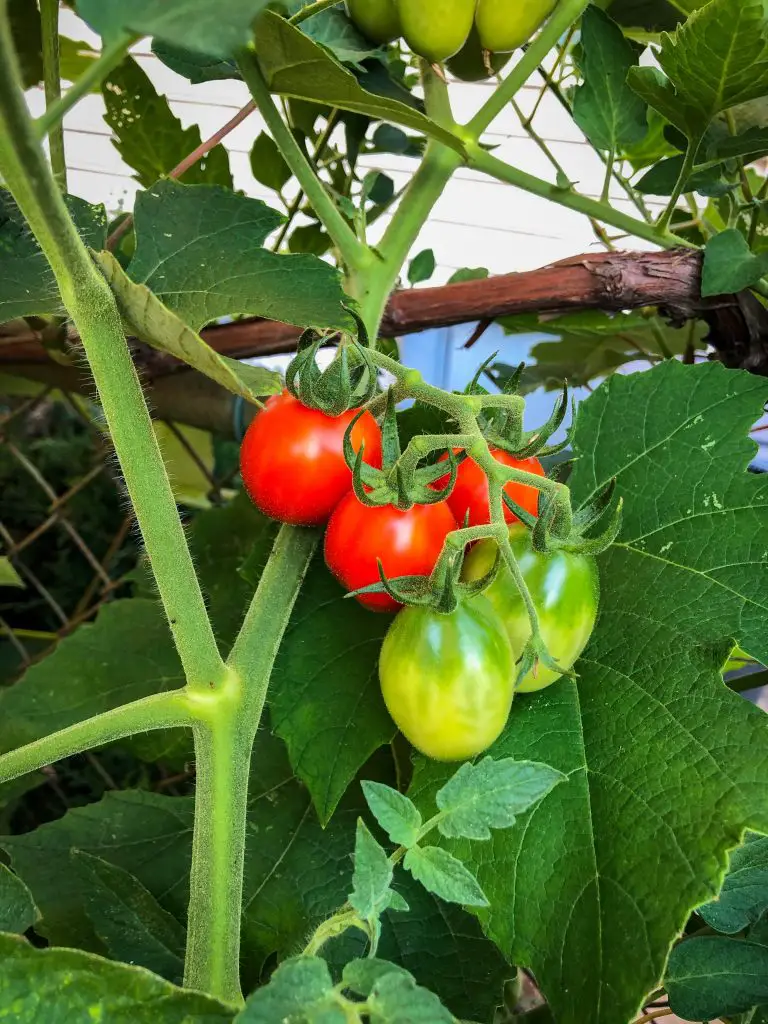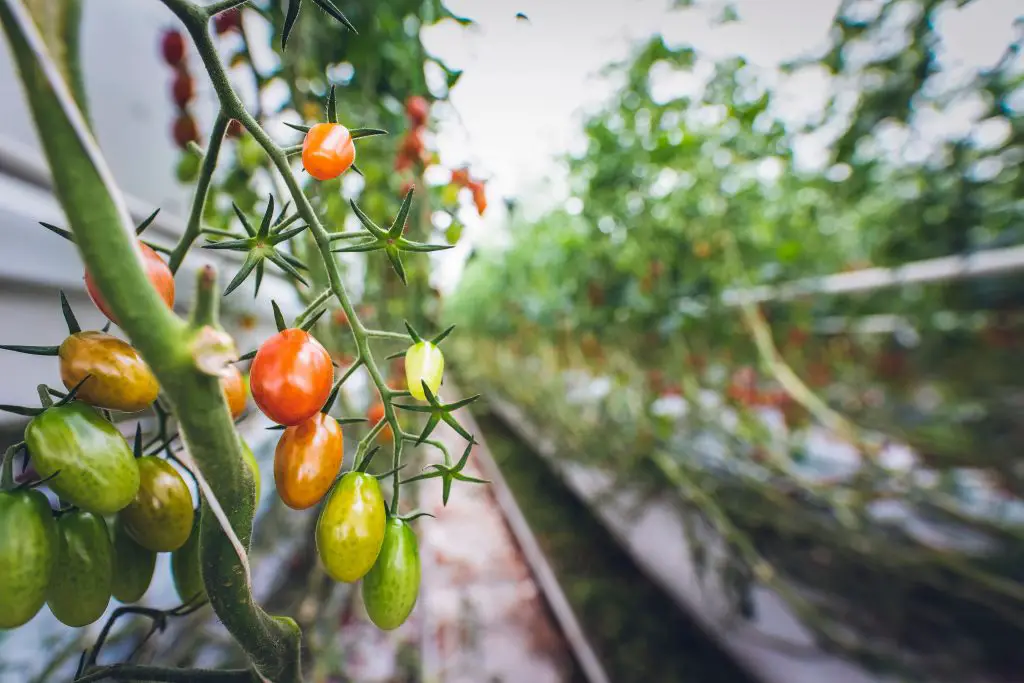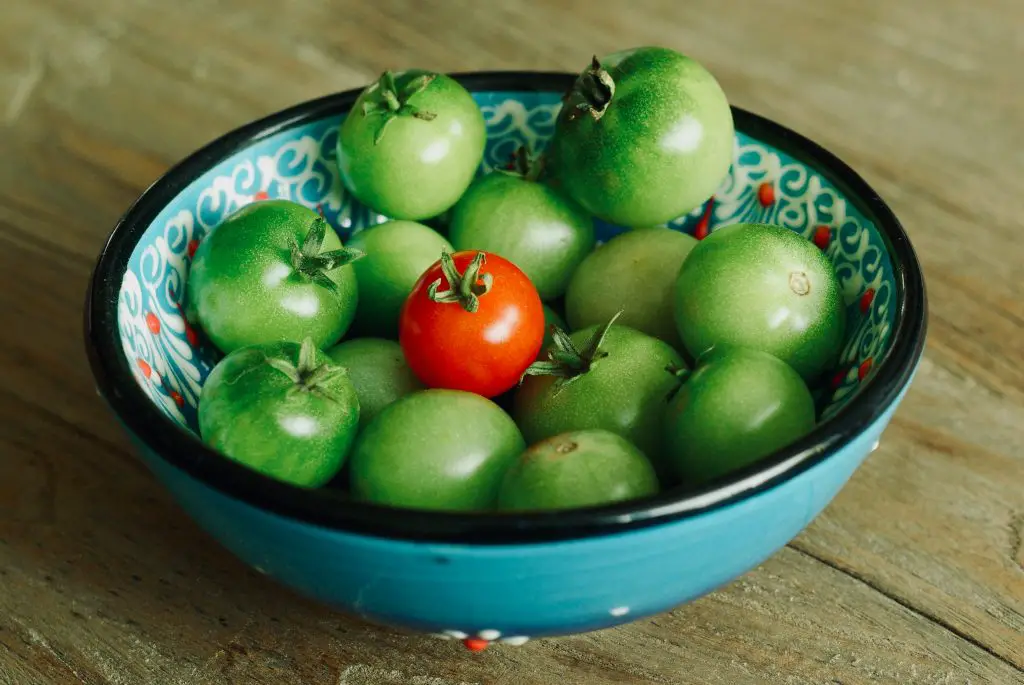Do You Need To Prune Indeterminate Tomatoes? There are two types of tomatoes, determinate and indeterminate. Determinate tomatoes, also known bush Tomatoes, are shorter tomatoes that reach a predetermined height before fruiting all at once. Indeterminate varieties are vine like Tomatoes that continue to get taller throughout the season progressively producing flowers as the plant develops. To read more about the differences between determinate and indeterminate plants click here. Given, that the tomato continues to develop do you need to prune them?
Indeterminate Tomatoes do need to have their side shoots removed as the plant develops which are the shoots that grow on a 45 degree angle between the main stem and a branch. However, the yield of the plant can be maximised by allowing the one or two side shoots to develop along side the main stem as it provides a greater number of flowering sites to form.

The side shoots can initially be pinched out by hand, however if the side shoot has become more established it is best to use secateurs to remove them otherwise there is potential to damage the main stem of the plant.
What Happens If You Don’t Prune Tomatoes?
Tomato plants produce quite vigorous growth once they get going and will produce numerous side shoots if allowed. Over the period of the growing season, if left unpruned the tomatoes will produce a mass of growth that will become a bit of a tangled mess. Once they are at this stage it is difficult to support the plant so you will often find that the plant sprawls along the ground.
If the fruit touches the ground at least some of them will be damaged by soil borne pests such as slaters. However, on the plus side the plant will still produce plenty of fruit.
Does Pruning Tomatoes Increase Yield?
The yield of a Tomato can be affected by pruning, but it is highly dependent upon the way in which the pruning is done. The most common advice provided is to remove all the side shoots by pinching them out. This allows the gardener to create a Tomato with a single stem that is neat and relatively easy to control.
However, this practices poses a couple of interesting questions;
- Does removing the side shoots affect the amount of fruit you get?
- What happens if we leave some of the side shoots on the plant?
If side shoots are left on the plant it will turn into a new stem over time. This means it is possible to have a plant with multiple major stems. An example of how someone has done this is shown in the video below.
To quantify the impact of doing this on the yield researchers at the University or Dhaka carried out a study on the effect of creating 1, 2 and 3 stem plants. A summary of the results presented in that paper are shown in the table below.
| Pruning | Fruit Per Plant | Wt. Per Fruit | Yield (kg/plot) |
| No Pruning | 34 | 87 | 35.0 |
| One Stem | 27 | 103 | 33.5 |
| Two Stem | 34 | 86 | 36.6 |
| Three Stem | 35 | 90 | 42.8 |
The results, interestingly, show that one stem pruning, which is what most home gardeners do is the least effective in terms of yield, however the method seems to produce the largest fruit. The reason for this is most likely that nutrients taken up by the root system are directed to a smaller number of fruit.
The best results were produced from 2 and 3 stem plants with the study citing other work in the article that produced similar results. Though there was also some disagreement on which type multi-stem plant produced the best yield with some studies finding that unpruned plants produced the highest yield.
Irrespective of the variability in the results it is apparent that multi-stem plants product a higher yield with more fruit, though the size of the fruit may be smaller.
What Happens If You Cut The Top Off Of A Tomato Plant?
The pruning practices discussed thus far have centred on managing the number of side shoots produced, however if you are growing an indeterminate Tomato which continues to get taller and taller, the obvious question becomes what happens if I cut the top of the Tomato plant off?

If removal of the top of the plant is done relatively early in the season it will generally result in the production of a greater number of side shoots. However, later in the season this is also done to encourage fruit to ripen before the first frost strikes.
This technique called “topping,” is typically done 4 weeks prior to the first frost. This type of pruning causes the plant to stop creating new flowers and fruit and redirects all the plant’s energies into ripening the remaining fruit. This encourages the fruit to ripen faster and also increases the chances that any green fruit left on the plant will ripen when brought indoors.
However, if the fruit does not ripen it is not the end of the world, as they can still be used in cooking or made into green tomato pickle if desired.
How to Ripen Green Tomatoes
As mentioned above Topping the plant about 4 weeks prior to the first frost will encourage the ripening of Tomatoes. However, it is also a good idea to leave the green Tomatoes on the plant as long as possible. This can be done by protecting the plant when the frosts are relatively light.
The advantage of doing this is it allows more time for the tomatoes to ripen in those Autumn days where you get frosty mornings but the remainder of the day is still sunny and bright. The best way to do this is using a plant protection blanket because they are easy to apply, are light weight and can be left on for days if required.

However, if the frost is heavy and the plants freeze despite the blanket being applied, the fruits are still edible but will not store for after-ripening. It is at this point that there will be little benefit in leaving the plants outside.
When removing the plants select only tomatoes of a reasonable size in good condition to keep, very small green tomatoes will not ripen. Leave the stem on the tomatoes as they will help to ripen the tomatoes.
To aid the ripening process you can either leave them on a window shelf or near other ethylene producing fruits such as bananas and pears, though neither one of these measures is essential for ripening they do speed the process up. When storing Tomatoes during the ripening process it is preferable to avoid having them touching each other. The reason for this is that if one goes bad it will not affect other Tomatoes you are trying to ripen.
Pruning Tips For Tomatoes
Apart from selecting laterals to keep or remove there is some additional pruning that is recommended to maintain a healthy plant. Tomatoes required lots of sunlight and also benefit from good air circulation to help avoid fungal diseases.
For indeterminate tomatoes it is best to remove all the leaves below the stem where the first fruit cluster appears. They are generally not required for photosynthesis and can provide an access point for disease and pests if they are touching the ground.
Additionally, any leaves that looks sickly or are beginning to yellow should be removed as they generally will not contribute to the growth of the plant and will reduce air circulation and light.
You can also prune back fruit clusters to limited number of Tomatoes ripening during the growing season. However, I personally don’t do this because I live in a region where the growing season is relatively long are there are alot of clear sunny days. This may be something you want to do you live in a place with a cooler climate where ripening all the fruit is a challenge.
Related Articles
Are Grafted Tomatoes Really Worth The Money?
What is the Difference between a Determinate or Indeterminate Tomato?
How Many Tomatoes Can You Get From One Plant?
Why Do Cherry Tomatoes Taste Better Than Regular Tomatoes?
How Can You Tell If A Tomato Flower Is Male Or Female? And How To Hand Pollinate Them.
Is It Too Late To Plant Tomatoes? And How To Make The Most Of Summer
Can You Plant Seeds From A Store Bought Tomato? (Is It Possible?)
